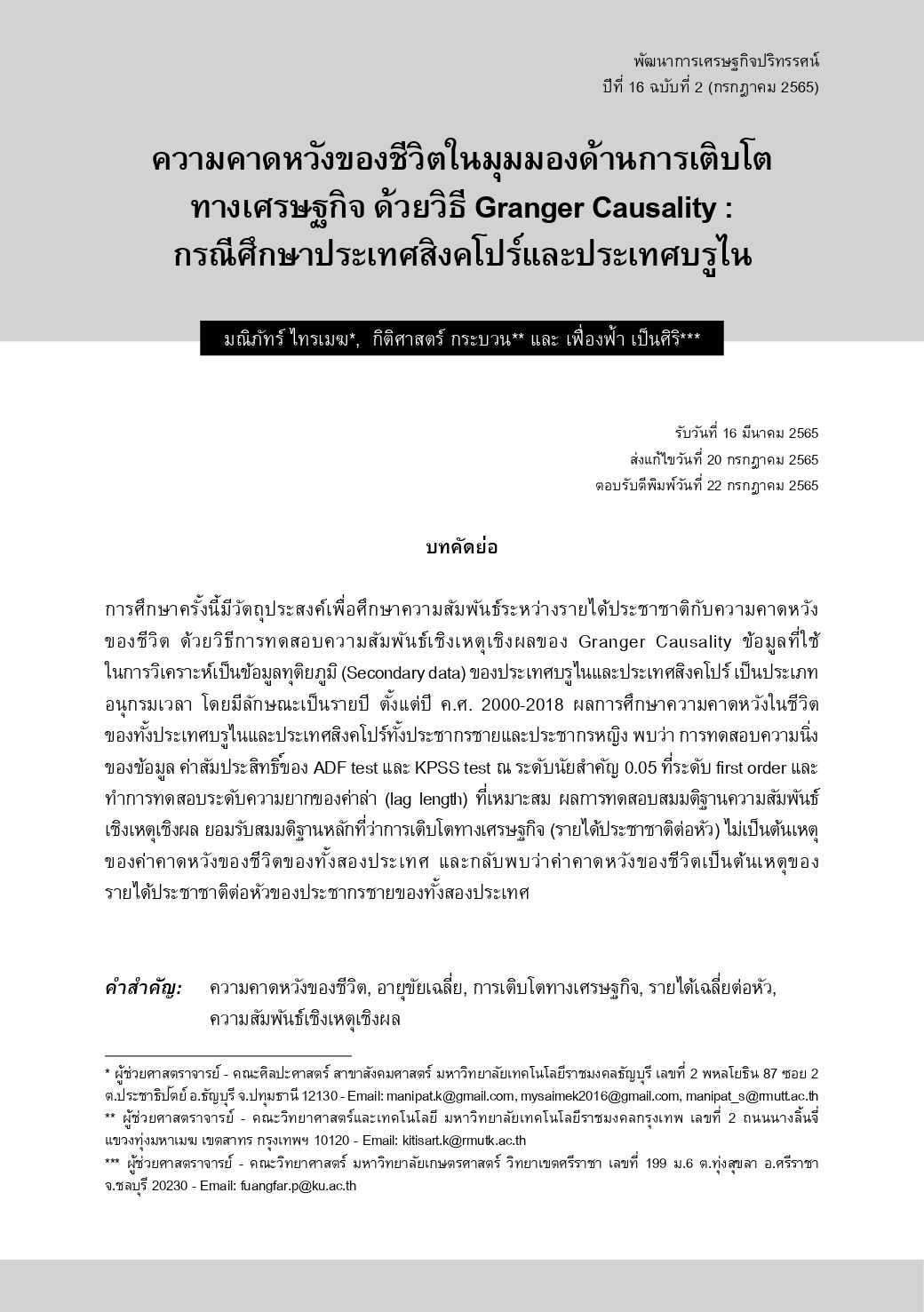LIFE EXPECTANCY FROM THE PERSPECTIVE OF ECONOMIC GROWTH WITH GRANGER CAUSALITY: SINGAPORE AND BRUNEI
Keywords:
Llife expancy, average lifespan, Economic growth, per capital income, granger causalityAbstract
The purpose of this study was to examine the relationship between national income and life expectancy by the Granger Causality test. The annual secondary data of Brunei and Singapore from 2000 to 2018 are utilized by time series analysis. The data stability, the coefficient of ADF and KPSS at the significance level 0.05 at first order and the appropriate level of life expectancy lag length of male and female populations in Brunei and Singapore were tested. The result showed that the Granger Causality test accepted the main hypothesis (H0) as the economic growth (national income per capita) was not a cause of life expectancy of both countries. On the other hand, life expectancy was a cause of economic growth of male population of both countries.
References
Acemoglu, D. and Johnson, S. (2007). Disease and Development: The Effect of Life Expectancy on Economic Growth. Journal of Political Economy, 115(6), 925-985.
Chirila, V. and Chirila, C. (2017). The Analysis of Romania’s External Migration and of the Causality between Remittances and Romania’s Economic Growth. Amfiteatru Economic, 19(46), 696-710.
Echevarria, A. and Lza, A. (2006). Life expectancy, Human Capital, Social Security and Growth. Journal of Public Economics, 90(12), 2323-2349.
Felice, E., Andreu, J. P. and D’lppoliti, C. (2016). GDP and life expectancy in Italy and Spain over the long run: A time-series approach. Demographic Research, 35(28), 813-866.
Korkmaz, S. and Kulunk, I. (2016). Granger Causality between life expectancy, education and economic growth in OECD countries. The Economic Research Guardian, 6(1), 1-17.
Kunze, L. (2014). Life expectancy and economic growth. Journal of Macroeconomics, 39 (Part A), 54-65.
Laditka. J. N. and Laditka, S. B. (2016). Unemployment, disability and life expectancy in the United States: A life course study. Disability and Health Journal, 9(1), 46-53.
Mahumud, R. A., Hossain, G., Hossain, R., Islam, N., and Rawal, L. (2013). Impact of Life Expectancy on Economics Growth and Health Care Expenditures in Bangladesh. Universal Journal of Public Health, 1(4), 180-186.
Paunica, M., Manole, A., Motofel, C., and Tanase G. L. (2020). Life expectancy from the
perspective of Global and individual wealth and expenditures: A Granger Causality study of some EU countries. Romanian Journal of Economic Forecasting, XXIII (4), 170-184.
Toda, H.Y. and Yamamoto. (1995). Statistical inference in Vector Autoregressions with possibly integrated processes. Journal of Econometrics, 66, 225-250.
Wang, S., Luo, K., Liu, Y., Zhang, S., Lin X., Ni, R., Tian, X., and Gao, X. (2015). Economic level and human longevity: Spatial and temporal variations and correlation analysis of per capita GDP and longevity indicatiors in China. Archives of Gerontology and Geriatrics. 61(1), 93-102.

Downloads
Published
Issue
Section
License
Copyright to published manuscripts becomes the property of the Graduate School of Development Economics, National Institute of Development Administration. Reproduction of all or part of a Development Economic Review (DER) article by anyone, excluding author(s), is prohibited, unless receiving our permission.
Disclaimer: Opinions expressed in articles published in this journal are those of the author (s) and do nto necessarily represent opinions of the Graduate School of Development Economics, National Institute of Development Administration. Trade and proprietary names are only for identification and not constitute our endorsement.

